
The silver-studded blue is a butterfly in the family Lycaenidae. It has bright blue wings rimmed in black with white edges and silver spots on its hindwings, lending it the name of the silver-studded blue. P. argus can be found across Europe and east across the Palearctic, but it is most often studied in the United Kingdom where the species has experienced a severe decline in population due to habitat loss and fragmentation.

The holly blue is a butterfly that belongs to the lycaenids or blues family and is native to the Palearctic.

The scarce large blue is a species of butterfly in the family Lycaenidae. It is found in Austria, Slovenia, Croatia, the Czech Republic, France, Georgia, Germany, Hungary, Italy, Japan, Kazakhstan, Mongolia, the Netherlands, Poland, Romania, Russia, northern Serbia, Spain, Switzerland, and Ukraine and East across the Palearctic to Japan. The species was first described by Johann Andreas Benignus Bergsträsser in 1779.

Kretania hesperica, the Spanish zephyr blue, is a species of butterfly in the family Lycaenidae. It is endemic to Spain. Its natural habitats are temperate shrubland and temperate grassland. It is threatened by habitat loss. Seitz describes it thus - hesperica Rbr. is above sky-blue instead of violet-blue; from Spain.

Kretania is a Palearctic genus of butterflies in the family Lycaenidae.
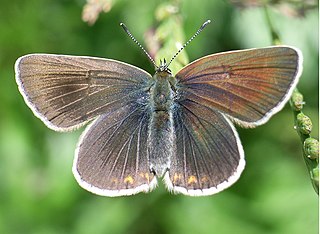
Eumedonia eumedon, the geranium argus, is a butterfly of the family Lycaenidae. It is found in the Palearctic realm. This butterfly has been included in the genera Plebejus, Plebeius, Polyommatus and Aricia, but recent molecular studies have demonstrated that Eumedonia is a valid genus, different from the previous genera mentioned.

Lysandra albicans, the Spanish chalk-hill blue, is a butterfly of the family Lycaenidae. It is found in Spain and Western North Africa.

Polyommatus daphnis, the Meleager's blue, is a butterfly of the family Lycaenidae.
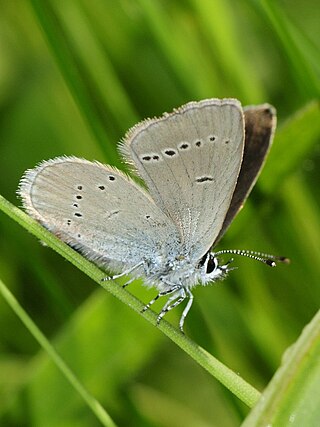
The Osiris blue is a butterfly in the family Lycaenidae. It is found in South Europe, Asia Minor, southern Siberia, the Alay Mountains, Tian-Shan, Dzhungarsky Alatau, the Altai Region, the Sayan mountains, Lake Baikal and Mongolia. It is often confused with the small blue, a closely related species.

Aricia morronensis, the Spanish argus, is a butterfly of the family Lycaenidae. It is found in Spain and Hautes-Pyrénées (France).

Leptotes webbianus, the Canary blue, is a butterfly in the family Lycaenidae. It is endemic to the Canary Islands.
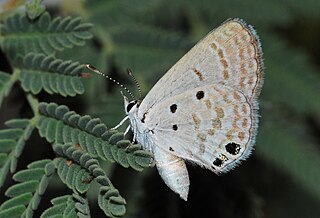
Luthrodes galba, the Persian grass blue, is a butterfly in the family Lycaenidae. It is found in southern Turkey, central and eastern Arabia, Iraq, Iran, Afghanistan, the Caucasus and Cyprus.

Kretania pylaon, the zephyr blue, is a butterfly in the family Lycaenidae. It is found in southern Russia and the Middle East to Iran. The habitat consists of dry habitats.

Polyommatus admetus, the anomalous blue, is a butterfly of the family Lycaenidae. It was described by Eugenius Johann Christoph Esper in 1783. It is found in south-eastern Europe and Turkey.

Polyommatus amor is a butterfly in the family Lycaenidae. It was described by Lang in 1884. It is found in Ghissar, Darvaz and the western Pamir Mountains.
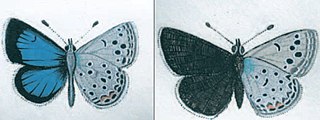
Turanana endymion, the odd-spot blue or Anatolian odd-spot blue, is a butterfly of the family Lycaenidae. It was described by Christian Friedrich Freyer in 1850. It is found in Turkey, Lebanon and Iran. Records from Europe refer to Turanana taygetica.
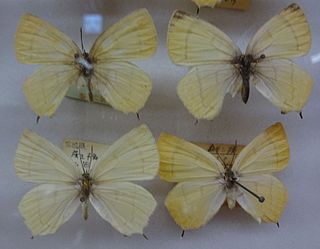
Shirozua jonasi, the orange hairstreak, is a butterfly of the subfamily Lycaeninae. It was described by Edward Wesley Janson in 1877. It is found in the Russian Far East, north-eastern China, Korea and Japan. It is widely distributed in the forest belt.
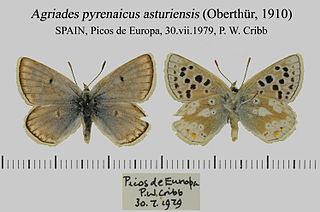
Agriades pyrenaicus, the Gavarnie blue, is a Palearctic butterfly of the family Lycaenidae. It is found in the Asturias mountains of north-western Spain, the Pyrenees, the southern Balkan Peninsula, Turkey, the Caucasus and Armenia. The habitat consists of alpine grassy rocky meadows where it is found at altitudes ranging from 1,500 to 2,200 meters.
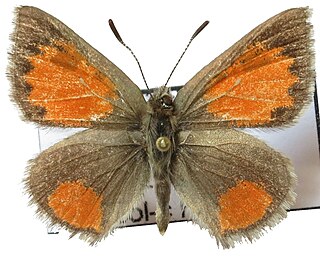
Tomares callimachus, the Caucasian vernal copper, is a butterfly of the family Lycaenidae. It is found in Anatolia, Iraq, Iran, the Caucasus, and Transcaucasia.

Kretania eurypilus, the eastern brown argus, is a butterfly found in the East Palearctic that belongs to the family Lycaenidae.




















